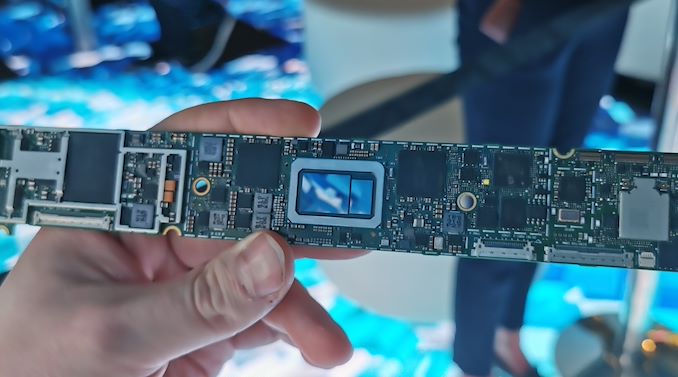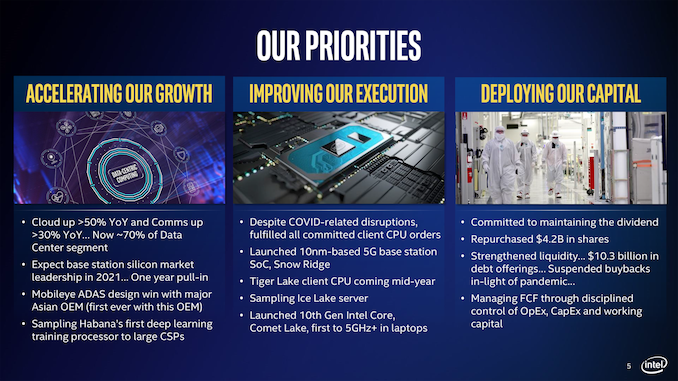Intel: Tiger Lake Client CPUs Coming Mid-Year
by Ryan Smith on April 24, 2020 10:00 AM EST
Along with detailing the nuts and the bolts of their Q1 2020 earnings, as part of Intel’s financial presentation, the company also offered a quick update on their upcoming Tiger Lake client CPUs. In short, the company is now preparing for volume production of the chips, and expects to being shipping them to OEMs mid-year.
Intel first unveiled Tiger Lake back at CES 2020 early this year, where the company briefly detailed the architecture while showing off a device using a prototype chip. Tiger Lake will be based on Intel’s latest Core CPU architecture, and will also be the first CPU from the company to integrate an iGPU based on their new Xe-LP graphics architecture. The chips will be based on a newer version of Intel’s 10nm manufacturing process than what’s used in the current ice Lake chips, which Intel is calling their 10+ process. At the time, Intel was promising that Tiger Lake devices would show up by the holidays, a similar time frame as 2019’s Ice Lake launch.
All told then, Intel’s most recent update is right in-line with their previous promises. With Tiger Lake being another mobile-first launch, OEMs need to receive chips well in advance of when consumer products will reach the store shelves, both to give OEMs the necessary time to finalize their designs, as well as to build up a suitable stockpile of devices for a proper retail launch. So, as it always needs to be said when talking about Intel’s timelines for manufacturing, while Tiger Lake chips will be shipping mid-year, we’re not currently expecting devices any sooner than what Intel has previously discussed.
Finally, if everything goes according to plan or Intel, it looks like the Tiger Lake launch should be a higher volume affair than Ice Lake’s. Cognizant of Ice Lake’s slow ramp-up and launch in 2019, Intel is telling investors that they are holding twice as many Tiger Lake CPUs in reserve as compared to Ice Lake. The company does need to master its updated 10+ process to get there, but with any luck, Intel’s 4+ years of playing with 10nm may finally pay some better dividends as they bring up their latest process.
#ontherun #TigerLake pic.twitter.com/Dhm1TwlcjV
— 𝐷𝑟. 𝐼𝑎𝑛 𝐶𝑢𝑡𝑟𝑒𝑠𝑠 (@IanCutress) January 8, 2020











140 Comments
View All Comments
yeeeeman - Friday, April 24, 2020 - link
Pcie 4.0 is not super important for 15w devices so I wouldn't count on it. It might support it but use a small number of lanes. Lpddr5 is important hopefully will be a feature.Alexvrb - Friday, April 24, 2020 - link
It is becoming increasingly important for M.2 drives regardless of the CPU TDP, since they're limited to 4 lanes. More so when Sammy launches a new Evo with a new 4.0 controller that rocks the mainstream storage market again. So having at least a handful of 4.0 lanes would give these chips/chipsets/boards broader range and more longevity.I'm not quite as sure LPDDR5 will be that important yet, although it depends on how much GPU they're willing to shove in a 15W chip. I'd wager LPDDR4X will still be sufficient, so I wouldn't be pissed if LPDDR5 doesn't make the cut.
yeeeeman - Saturday, April 25, 2020 - link
Lpddr5 will bring efficiency inprovements. Bandwidth is more than enough with lpddr4x alreadymode_13h - Saturday, April 25, 2020 - link
As yeeeeman said, PCIe 4.0 is not relevant for 15 W laptops. It's too power-hungry. And if that weren't enough, the real-world benefit even for higher-powered devices is minimal.Deicidium369 - Saturday, April 25, 2020 - link
The higher power variant of Tiger Lake for NUC11 will have a 4x PCIe4 M.2 storage as well as 2.5Gb ethernet. Have not seen mention of DDR5 of any flavor - likely first platform will be Sapphire Rapids which will be PCIe5 and DDR5. There is a small chance it could be on Rocket Lake.Deicidium369 - Saturday, April 25, 2020 - link
Tiger Lake is PCIe4 but likely not LDPPR5. The follow up to TGL will likely have LPDDR5.Much more than just larger caches - both wider and deeper than Skylake.
ksec - Friday, April 24, 2020 - link
>Finally, if everything goes according to plan or Intel, it looks like the Tiger Lake launch should be a higher volume affair than Ice Lake’s.That is the key difference here, Icelake launch was really pushed just to show 10nm is actually OK. They were very hesitant to share out their shipping details. Being forthcoming about Tigerlake *shiping* to OEM mid year means they are quite confident about it.
That said we dont know what TDP series are they launching with Mobile.
AMD needs to move fast. Their marketing, and sales execution isn't doing good.
Deicidium369 - Saturday, April 25, 2020 - link
Shipped in late May early June to OEMs - bought the Dell 13 2-in-2 and got in October. But was also lower volume for 10nm, and 10nm+ is alot higher volume.Tiger Lake will be in laptops/ultralights just like Ice Lake - but what I am looking forward to is the NUC11 with TGL - I have around 65 NUCs deployed over 3 generations - even the old ones are OK for our needs, but the graphics start to lag hard with dual 2560 or dual 4K - Gen12/Xe LP will be a welcome upgrade - the PCIe4 M.2 and 2.5Gb/s Ethernet is not bad either.
I think that Lisa Su's expectations of sales volume for Ryzen/Epyc is not what she was hoping for - it's always the next one that finally does whatever. Ryzen 1 - I dont think there was much expectations, but the refresh (2x00) I think was expected to be a sales hit - which it was not - same with Zen 2 - not huge sales successes - not failures - but no where near what she needed to start funding R&D. Ryzen 1 2 3 are just small iterations, and are what Keller left her with.
Spunjji - Monday, April 27, 2020 - link
It's weird how the part of your post concerning Intel all makes sense, and then you just say... "stuff" about AMD. Zen 2 (3000 series) was AMD's Haswell moment - not a "small iteration". All indications point to a similar leap with Zen 3.Overall sales volume compared with Intel isn't going to give you a useful idea of how they're doing, because AMD are playing from a position of historic weakness. Their relative growth reflects the strength of the products - Zen 2 has been a huge sales success on desktop. It'll take longer to make inroads into the server market due to the lengthy product cycles, but Zen 2 obliterates Intel there and it's not clear Intel have anything significant to respond with in the near future either.
AMD are definitely struggling with sales on the mobile side. Looks like poor alignment with OEM product cycles, lack of OEM trust after the mediocre 2000/3000 series, and lack of volume production are mostly to blame so far, as the product itself is sound.
Deicidium369 - Monday, May 4, 2020 - link
AMD is struggling with sales on every single product they offer.